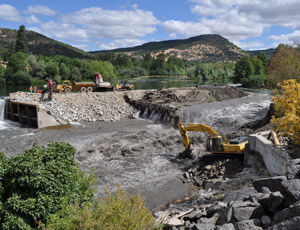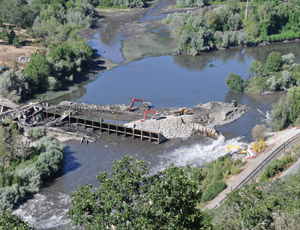During the dismantling of Gold Ray Dam, a 106-year-old timber cofferdam and 70-year-old concrete dam near Medford, Ore., the Rogue River blew through a sand spit, changing course and freeing the river�s run for the first time in over a century.


Scott Wright, project manager for the Corvallis, Ore., office of design-build contractor River Design Group, says that the entire process actually sped up the crew’s work by almost two weeks.
Crews built two temporary sand and gravel cofferdams—one in the river and one in adjacent Tolo Slough—to ease the removal of the permanent structures. As crews started tearing out the temporary Tolo Slough dam in mid-August to let the river run through a section of the removed concrete dam, an upstream sand peninsula tied into the temporary structure developed a leak. Crews tried to stop it with sand and gravel, but “eventually it started to pipe too much material in there and created a break,” Wright says.
That break grew and sent the river rushing through the sand and the portion of the dam that had been removed, temporarily stranding equipment. “It happened the way we were planning, but more than a week early,” Wright says. “It made for pretty easy demolition on the concrete. We demolished over half the dam in a week, taking about two weeks to take the concrete out.”
Jim Vial, Jackson County roads and parks manager, says that while completely unexpected, it worked out. “Once we determined it was okay, we said ‘let it rip’ now,” he says.
Using standard track-hoes mounted with picks and crushers, crews finished removing the 18-in.-thick, 38-ft- tall concrete portion in under two weeks.
The temporary dams created a big enough opening in the dam to work outside the water. Floating silk curtains attempted to trap as much sediment and silt as possible.
Crews plan to remove the 106-year-old, 3-ft-thick, 34-ft-high log dam by breaking up old concrete and yanking out the logs, which get reused in restoration efforts.
The old dam offered more than crew bargained for, Vial says, as the mix of timber, concrete and rip rap formed “quite a dam.”
Construction crews scrambled to get the equipment off the temporary dam a different direction. Meanwhile, roughly 25 volunteers worked rapidly to save fish by netting and relocating them when the sudden rush of water depleted Tolo Slough and nearby Kelly Slough. Fish caught in a dewatered fish ladder were released through a hole cut in the concrete, allowing the fish to keep pace with the river.
A third dam—a vintage 1904 version discovered upstream once the water level diminished—will likely be removed once a change order to the overall $5.5 million project gets established.
While a group of farmers formed a group to save the old dams, Jackson County deemed the structures a useless liability. Originally built as a power generating facility, the dam was decommissioned in 1970 and labeled as one of the worst fish-killing dams in the state.




Post a comment to this article
Report Abusive Comment